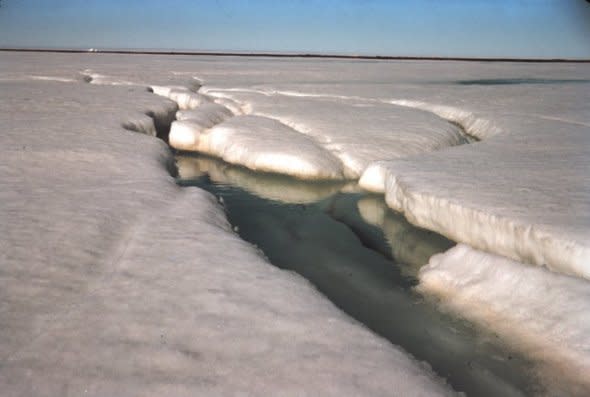Warming Arctic may lead to methane boost, abrupt permafrost thaw
As Arctic permafrost thaws, greenhouse gases are released into the atmosphere.
This may accelerate abrupt thawing and influence the formation of certain types of Arctic lakes, boosting emissions even further, according to new research.
One of the world's largest reservoirs of organic carbon lies in the Arctic soil. As the permafrost thaws, microbes in these once-frozen soil layers transform the carbon into carbon dioxide and methane, which is then released into the atmosphere.
"Methane is a potent greenhouse gas. As more methane is released into the Arctic atmosphere, more heat is trapped closer to the surface and the temperature rises, which in turn melts more permafrost and so on," AccuWeather Senior Meteorologist Brett Anderson said.
As more greenhouse gases are released, the subsequent warming in the region can lead to abrupt thawing, influencing the formation of Arctic thermokarst lakes, according to the study results published in Nature Communications in August.

(Photo/NOAA)
"As temperatures continue to rise in the Arctic region more of the permafrost is thawed, [it] in turn softens and sinks the ground, which can lead to the formation of more lakes," Anderson said.
Thermokarst lakes form in the soft, Arctic earth as permafrost thaws and contain a substantial amount of greenhouse gases.
"The mechanism of abrupt thaw and thermokarst lake formation matters a lot for the permafrost-carbon feedback this century," the study's lead author Katey Walter Anthony told NASA in August.
Walter Anthony, an aquatic ecosystem ecologist and University of Alaska, Fairbanks, led the project, which was part of NASA's Arctic-Boreal Vulnerability Experiment (ABoVE).
"We don't have to wait 200 or 300 years to get these large releases of permafrost carbon. Within my lifetime, my children's lifetime, it should be ramping up," she said.
One of the more unique Arctic lakes Anthony has studied looks like it is boiling, as it hisses and bubbles due to large emissions of methane from beneath the water.
The lake, which Anthony named Esieh Lake, is nearly 20 football fields in size and sparked initial fears that it would explode due to the amount of methane being released, according to a report from the Anchorage Daily News.
In addition to increased greenhouse gas emissions due to thawing permafrost, rapid Arctic sea ice melt is also a contributing factor in the region's warming.
The Arctic system differs greatly from the Antarctic due to the different geography of each region. Arctic warming is occurring more rapidly than models predicted and at a rate that is more than double the rest of the world, NOAA oceanographer James Overland told AccuWeather last year.
According to the National Snow and Ice Data Center, Arctic sea ice extent for December 2017 was 11.75 million sq. km. The December extent in 2016 was 11.47 million sq. km, which was the second lowest December extent in the satellite record dating back to 1979.
For years, scientists could find Arctic ice floes upwards of 10 years old, NSIDC Director Mark Serreze told AccuWeather last year.
"You really don't see that anymore," Serreze said.
The Arctic sea ice has not only undergone significant melting in recent years, he said, the ice is now younger and thinner than it once was.
With increased ice melt, the Arctic also opens up a dark ocean surface, allowing the absorption of more sunlight. In turn, this causes more of a warming effect, which makes it an entirely different system than the large, thick ice sheet of the continental Antarctic, Serreze said.
"We are also seeing more soot in the Arctic, which is also darkening the surface snow and ice," Anderson said. " The longer-term trend of December Arctic sea ice extent has been in a fairly steep decline."
The loss of sea ice and increases in abrupt permafrost thaw may only exacerbate the warming in the region through a feedback loop.
"As more sea ice is lost in the Arctic, we have more open water, which allows more heat to build in the region," he said.
